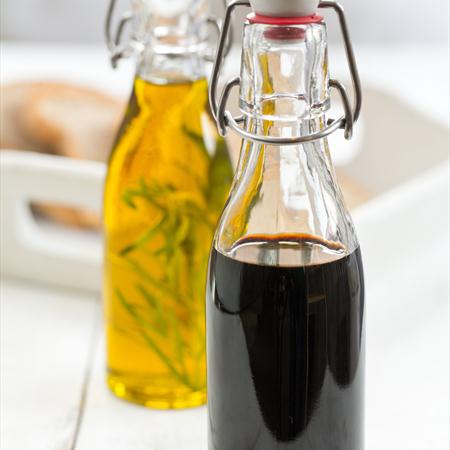Balsamic Vinegar
 |
|
Balsamics are very different from other vinegars. The dark, syrupy liquid will add an amazing taste to fruits, salads, and vegetables. |
See also vinegar.
Authentic balsamic vinegar is a syrupy reduction of sugary grapes. Following fermentation and cooking, vinegar “mother” is incorporated and the aging process begins. As the liquid moves from barrel to barrel, it acquires the scent from the different woods used to make each cask. Modena, Italy, is the famous region where this fashionable vinegar is made.
Commercial products are readily available. They will not have the flavor or consistency of true balsamics, but some are very good and more affordable.
Buying Tips
- Traditionally-aged top quality balsamic vinegars are very expensive. The label will state “aceto balsamico tradizionale.” In addition, vinegars aged more than 25 years (some as long as 150 years) will be labeled “extra vecchio.” Italy’s Traditional Consortium of Balsamic Vinegar tests each batch before granting approval for bottling.
- Many consumer brands have been aged much less than twelve years, which will be reflected in the price. Some of these are listed as “condimento,” and can be recommended for use in sauces and marinades.
- The “must” (unfermented grape juice) that makes up true balsamic will be listed on the bottle. More economical brands will have some “must” along with red wine vinegar. Many of these come from Italy, but are now produced in other countries as well.
- Imitation balsamics will have no “must” and may have sugars added for thickening. They often incorporate preservatives such as sulfite along with added coloring. These are not recommended as an alternative.
Storage Tips
Store in a glass container with a proper seal. Balsamics can become tainted by odors; keep separated from aromatic foods.
Usage Tips
Think of balsamic vinegar as a concentrate. A little goes a very long way. The older the vinegar, the less you should use. Often, a few drops are enough.
Serve artisan quality vinegars at the table. When cooking, use commercial products. There is a wide range of flavors among mass-produced balsamics, so don’t be disappointed if a particular taste is not to your liking. Keep looking until you find a brand with just the right intensity.
Use commercial balsamics in stir-fries instead of soy sauce. Add to marinades along with Worcestershire sauce.
Try one of our favorite balsamic vinegar recipes:
Balsamic-Glazed Pearl Onions
Lamb Chops with Balsamic Reduction





